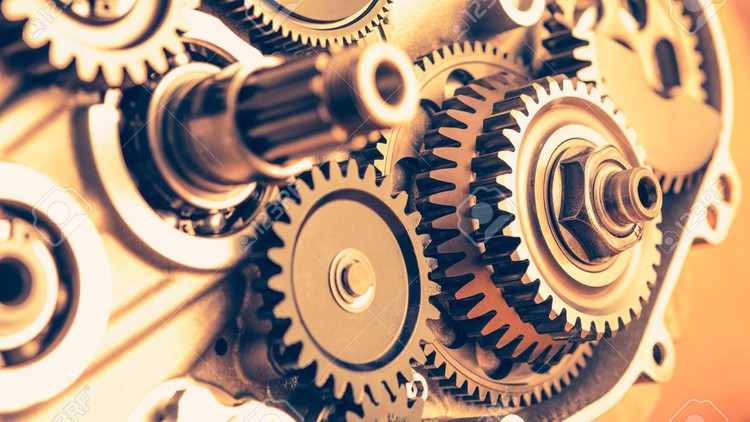
Mechanical Engineering, Manufacturing & Production Engineering, Machines & Mechanisms, Gear & Gear Trains, CAM & Profile
What you will learn
Link, pairs, Chain, Structure
Mechanism & Machine
Degrees of freedom, Criterion of Grubler and kutzbach
Inversion of four bar chains, mechanism with lower pairs
Velocity Analysis, I- Centre Method, Relative Velocity Method
Gear Drive, Types of Gear, Types of Gear Trains
CAM & FOLLOWER, Terminology of CAM & FOLLOWER, Follower Motion with Uniform Velocity, SHM etc
Working of Governor, Types of Governor
Description
The subject Kinematics of Machines also known as KOM is a very special course for the Mechanical Engineers. This course tells us about the distinctive features of the machines. This tells us how the machine works. In this course, we will study about the working of the machines. How they work? What would be the speed of output is some input speed is given. What would be the acceleration and so on.
The main part of this course is the study of machines. A machine is a tool which converts one form of energy to some useful work. For example an engine converts thermal energy into mechanical energy. So the engine would be a machine. A lathe machine converts electrical energy into some useful mechanical work, so it is a machine.
Although, we will discuss the machine in detail in later part of the tutorials, but the basic definition is “A machine is a combination of rigid or resistant bodies, formed and connected do that they move with definite relative motions and transmit force from the source of power to the resistance to be overcome. A machine has two functions: transmitting definite relative motion and transmitting force. These functions require strength and rigidity to transmit the forces.
After undergoing this course, the students will be able to:
· Explain working of different types of mechanisms and draw their inversion.
· Gear Drives, Types of Gear Drives, Gear Terminology, Gear Trains.
· Determine ratio of driving tension for flat and V-belt drive.
· identify various types of gears and their applications.
· Construct Cam Profile etc.
मशीनी इंजीनियर्स के लिए किमैटिक्स ऑफ मशीन्स को KOM के रूप में भी जाना जाता है। यह कोर्स हमें मशीनों की विशिष्ट विशेषताओं के बारे में बताता है। यह हमें बताता है कि मशीन कैसे काम करती है। इस पाठ्यक्रम में, हम मशीनों के काम के बारे में अध्ययन करेंगे। वे कैसे काम करते हैं? आउटपुट की गति क्या होगी कुछ इनपुट स्पीड दी गई है। त्वरण और इतने पर क्या होगा।
इस पाठ्यक्रम का मुख्य भाग मशीनों का अध्ययन है। एक मशीन एक उपकरण है जो ऊर्जा के एक रूप को कुछ उपयोगी कार्यों में परिवर्तित करता है। उदाहरण के लिए एक इंजन थर्मल ऊर्जा को यांत्रिक ऊर्जा में परिवर्तित करता है। तो इंजन एक मशीन होगा। एक खराद मशीन विद्युत ऊर्जा को कुछ उपयोगी यांत्रिक कार्यों में परिवर्तित करती है, इसलिए यह एक मशीन है।
हालांकि, हम ट्यूटोरियल के बाद के हिस्से में मशीन के बारे में विस्तार से चर्चा करेंगे, लेकिन मूल परिभाषा है “एक मशीन कठोर या प्रतिरोधी निकायों का एक संयोजन है, जो कि गठित और जुड़ा हुआ है जो वे निश्चित सापेक्ष गति के साथ चलते हैं और स्रोत से बल संचारित करते हैं। प्रतिरोध की शक्ति पर काबू पाने के लिए। एक मशीन के दो कार्य होते हैं: निश्चित सापेक्ष गति को संचारित करना और बल संचारित करना। इन कार्यों के लिए बलों को संचारित करने के लिए शक्ति और कठोरता की आवश्यकता होती है।
इस पाठ्यक्रम से गुजरने के बाद, छात्र निम्नलिखित में सक्षम होंगे:
• विभिन्न प्रकार के तंत्रों के कार्य को समझाइए और उनके व्युत्क्रम को आकर्षित कीजिए।
• गियर ड्राइव, गियर ड्राइव के प्रकार, गियर शब्दावली, गियर ट्रेनें।
• फ्लैट और वी-बेल्ट ड्राइव के लिए ड्राइविंग तनाव का अनुपात निर्धारित करें।
• विभिन्न प्रकार के गियर और उनके अनुप्रयोगों की पहचान करना।
• कैम प्रोफाइल आदि का निर्माण।
Content